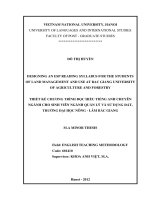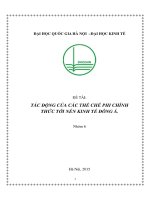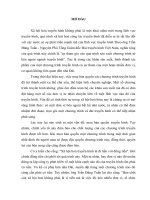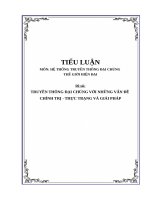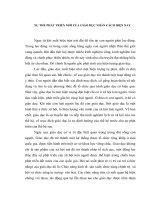(TIỂU LUẬN) this report will cover the articles profile of event management and use that as the basis to investigate the event “vietnam expo 2019
Bạn đang xem bản rút gọn của tài liệu. Xem và tải ngay bản đầy đủ của tài liệu tại đây (570.35 KB, 15 trang )
TABLE OF CONTENT
INTRODUCTION____________________________________________________________________4
SECONDARY RESEARCH___________________________________________________________5
INVESTIGATION – VIETNAM EXPO 2019_____________________________________________7
1. Overview___________________________________________________________________7
2. Marketing___________________________________________________________________7
3. Operation___________________________________________________________________7
4. Risks Management__________________________________________________________8
FUTURE DEMAND__________________________________________________________________9
CONCLUSION AND RECOMMENDATIONS__________________________________________10
1. Conclusion_________________________________________________________________10
2. Recommendations_________________________________________________________10
APPENDIX________________________________________________________________________11
REFERENCES_____________________________________________________________________14
INTRODUCTION
The tourism industry has tremendous impacts on the economy of many countries (Hodur & Leistritz
2007). One of the fastest-growing sectors contributing to that is the MICE business (Daniela, Patricia
& Cristiana 2011). The term “MICE” stands for meetings, incentives, conventions, and exhibitions, of
which purposes exceed leisure tourism, therefore attracting business customers (Lau & Bureau 2016).
In the age of globalization and technology, MICE events are essential for information exchange,
international trades, and economic growth (Schlentrich 2008).
The very first form of events was gatherings where people exchange goods, experience, and
knowledge (Schlentrich 2008). The scales started expanding rapidly in the 1760s as a result of the
Industrial Revolution in Great Britain. Trade organizations around the world needed a space to
exchange with one another, which led to the first modern exhibition in Britain in 1851, the Crystal
Palace Exhibition (Schlentrich 2008). Since then, the United States, European countries, and China
have risen to lead the industry, with the USA being the most dominant event destination. Recently, the
market size in Asian countries is growing rapidly (Daniela, Patricia & Cristiana 2011). In 2019, the size
of the global event industry was $1,135.4 billion (Allied Market Research 2021).
Exhibitions, in which products, services, information are presented to interested participants, vary from
art galleries and museums to commercial exhibitions and trade fairs (Trišić & Arsenov-Bojović 2018).
Exhibitors participate to get sales leads, introduce new products, build networks, gather information
about the competitors, and build the company’s image (Lau & Bureau 2016). Trade shows and
commercial exhibitions in Vietnam mainly serve the purpose of promoting and presenting products
and connecting the domestic and global markets. Vietnam Expo, an annual event at the International
Exhibition Center in Hanoi hosted by the Ministry of Industry and Trade, is one of the most prestigious
trade promotion events in Vietnam. It connects domestic and global enterprises, therefore enhancing
import and export, increasing sales in the domestic market, and helping local businesses join the
global scene and vice versa (Vietnam Expo 2020). The first Vietnam Expo was held in 1991. Over the
years, the number of exhibitors and visitors participating has risen steadily despite a setback in 2020
and 2021 due to COVID-19. In 2019, the event attracted over 500 exhibitors from 23 countries and
territories and approximately 21 thousand international and domestic visitors (Tradepro 2021).
This report will cover the articles profile of event management and use that as the basis to investigate
the event “Vietnam Expo 2019”. Using the implications from the investigation and predictions of future
demand in Vietnam, recommendations will be provided for the Vietnamese tourism industry.
SECONDARY RESEARCH
There are various types of exhibitions, namely fairs, expositions and exhibitions, expo (large
expositions), trade fairs, trade shows (business to business), public shows (business to customer),
mixed shows (open to both businesses and the public) (Beier & Damböck 2006). These events vary in
size but overall, the total exhibition space and the number of shows and venues have been increasing
(see Figure 1), indicating that the demand for exhibitions has risen.
Global Estimates from 2006 - 2017
36
1240
35
1220
34
1200
32
1180
31
1160
30
million m2
33
29
1140
28
1120
1100
27
2006
2011
2017
26
Figure 1. Global Estimates of Exhibitions from 2006 – 2017 (An, Kim & Hur 2021; UFI 2014)
The types and numbers of tourists and the aims of an exhibition depend on its size. Hallmark and
mega exhibitions can enhance the reputation and attractiveness of the host destinations, thereby draw
in a huge number of tourists and have both short-term and long-term impacts on the economy
(Oklobdžija 2015; Vu 2021). Events in general also help elongate the tourism seasons of event
destinations (Trišić & Arsenov-Bojović 2018). The three flows of economic benefits from event tourism
are from the facility construction, the operation of the event, and the expenses of attendees and
participants (Morgan & Condliffe 2007; Hodur & Leistritz 2007). The construction phase provides an
enormous one-time gain to the local economy through employment opportunities and expenditures.
During the operation of an exhibition, there are also jobs provided and direct income from registration
or ticket fees. The last source of benefit is visitors’ expenditures on products and services outside of
the event, such as transportation, accommodation, food and beverage, and entertainment (Trišić &
Arsenov-Bojović 2018). In 2015, 74.68 million domestic trips involving events in England yielded
£6,050 million (Visit England n.d.).
The complex and flexible nature of events in which no two days are the same requires event
managers to understand and apply multiple theories to the creating and producing process (Silvers &
Nelson 2009; Silvers et al. 2005). One of the internationally used frameworks is the Event
Management Body of Knowledge (EMBOK). It provides a comprehensive and systematic approach to
managing the risks involved in all types and sizes of events (Silvers 2004). EMBOK identified five
functional areas of event management as administration, design, marketing, operations, and risks (see
Figure 2).
Figure 2. EMBOK Model (Silvers & Nelson 2009)
To assure the success of an event, the marketing strategy has to appeal to the target segments as
effective marketing depends on both the sender and the receiver (Hede & Kellett 2011). The
understanding of demographic, geographic, and psychological characteristics is essential to design
and implement an effective marketing strategy that can influence the consumer decision-making
process (Vu 2021). Digital marketing communication is an emerging communication strategy in this
time when the IT revolution is integrated into people’s lives (Holm 2006). Especially on social media
platforms where information about an event can reach a vast audience, organizers can measure the
effectiveness of the event promotion and the event itself (Inversini & Sykes 2013).
In an exhibition, aside from managing facilities and equipment, the choice of venue, the registration or
ticketing process, and the layout and flow of the event are crucial for the organizers, the exhibitors,
and the attendees (Tum & Norton 2006). Organizers have to consider the participant requirements, the
press and media, and safety and emergency procedures. Aside from the safety of participants on-site,
there are risks related to legal and political issues, social responsibility, etc. depends on each
exhibition (Milanović & Ješić 2014; An, Kim & Hur 2021). Being well-prepared for these risks is the
responsibility of the event organizers.
INVESTIGATION – VIETNAM EXPO 2019
1. Overview
The 4-day long event in Hanoi had the theme “Connect – Share – Succeed”. Aside from the purpose
of connecting the domestic and global markets that it shared with the previous 28 shows, Vietnam
Expo 2019 emphasized helping local businesses develop through free seminars and training for
attendees organized by Vietnam and Korea (Hoang 2019; VNS 2019). Most event participants, who
were from the business sector (Tradepro 2019, Luu 2019), attended to promote their products, build
networks, and learn to develop their businesses.
2. Marketing
As a prestigious event that had been held for 28 years, before the event date, information about
Vietnam Expo 2019 was on the national television channels, various e-newspapers, and websites and
social media pages for businesses (see Appendix 1 & 2). The organizers also sent invitations to
potential exhibitors, some of which were on public websites for Vietnamese businesses (see Appendix
3).
To deliver the information to interested parties effectively, a website for the exhibition was built (see
Appendix 4). Not only did it provide information about Vietnam Expo 2019 (for example, timeline and
floor map), exhibitors (booth fee for instance), and news about the exhibition, but it also allowed
visitors to register to attend the event as exhibitors or visitors.
Though the exhibition did have a Facebook page and there were hashtags related to the event, the
engagement levels were not impressive. This might be because the page was built solely to provide
information, not encouraging interactions from viewers. Also, since most event participants were
above 35 years old (as seen in most photos taken during the exhibition) and attended for work
purposes, they were not active on Facebook (see Appendix 5 & 6).
3. Operation
The exhibition was held at the International Exhibition Center (ICE) in Hanoi, featuring over 500
exhibitors from Vietnam and 23 countries and territories in 600 booths and attracted 21 thousand
visitors from businesses and the public. The venue was divided into the International zone, Vietnam
Value zone, Industrial Products zone, and the Consumer Products zone for effective navigation.
However, due to the limited area, the number of businesses attending the exhibition was restricted
(Huong 2019).
Attendees had to register through the website before a due date, which assisted the organizers in
planning the logistics and flow of the event. Though most of the participants were at ICE over the
course of 4 days, some additional seminars were organized in other locations within Hanoi. Therefore,
a clear schedule along with the floor map was provided for attendees to visit and register for seminars
they wanted to attend. This helped lessen the human traffic at the venue.
4. Risks Management
In an offline international scale exhibition, there are many risks even before the on-event dates. In
Vietnam Expo 2019, there were exhibitors from China, Korea, Russia, etc., whose presence had
impacts on Vietnam’s cooperate opportunities with global markets. As a result, planners would have to
consider political and economic factors when organizing the booths. The exhibition also came with
medical and physical risks such as disease outbursts, accidents, or criminal activities (Milanović &
Ješić 2014; Beier & Damböck 2006). This required the event managers to have detailed safety
procedures, insurance, and a trained workforce to handle any possible risks. A completed participant
record was critical so that the organizers could keep track in case of an infectious disease.
As Vietnam Expo is a prestigious exhibition with history, it was important for the organizers to be wellprepared for these types of risks to uphold the image and reputation of not only the event but also the
country in the international market.
FUTURE DEMAND
The Asia-Pacific region is a dynamic economic hub that is developing rapidly and its event industry is
expected to have the highest compound annual growth rate (CAGR) of 13.3% compared to other
regions by 2028 (Allied Market Research 2021). Despite the delay caused by COVID-19, the event
industry in Asia-Pacific is expected to continue growing starting from 2021 (Heo 2021). The pandemic
has also brought up the demand for strict risks management, especially health risks, and virtual
events. The MICE sector has a remarkable contribution to Vietnam’s tourism as the revenue
generated was six times higher than other types of tourism as of 2019 (VIR 2021). However, the lack
of space, infrastructure, and facilities was a hindrance to its development when the number, scale, and
purpose of exhibitions kept increasing (Le 2019).
CONCLUSION AND RECOMMENDATIONS
1. Conclusion
Exhibitions, and events in general, are effective gateways to develop the tourism industry, hence the
economy of a country. The variety in types, scales, and purposes requires an event management
framework, which is EMBOK in this report, to minimize the risks and increase the economic benefits.
The MICE industry in Vietnam has brought numerous opportunities to the local industries and the
national economy, evident in exhibitions such as Vietnam Expo 2019. The investigation of this event
has pointed out elements that need to be improved to satisfy the accelerated demand for MICE.
2. Recommendations
To quickly adapt to the consequences of COVID-19, event organizers must develop effective platforms
for virtual events. Travel restrictions have negatively affected the success of many events such as
Vietnam Expo 2021, in which the number of exhibitors declined by 200 compared to the figure for
2019 despite having combined live and online exhibitions through remote booths (Lam 2021). A
technology that can be used is virtual reality, which creates a simulated environment (Bardi 2020) that
greatly enhances the experience of visitors at virtual exhibitions compared to flat screens.
As the event industry in Asia is predicted to expand soon and some countries have vaccinated their
citizens, Vietnam needs to upgrade existing venues and build new ones to meet the booming demand.
However, the expansion must be strategically planned on the national scale as constructing new
venues may backlash if supply exceeds demand (Morgan & Condliffe 2007) and the current situation
in Vietnam has yet to allow construction.
If Vietnam wants to be able to welcome visitors to offline events, strict health and safety procedures
such as tests to assure the health status of all participants before and after the event or the floor
planning of the event and designs of booths to practice social distancing effectively must be applied.
Finally, since the number of events in general and exhibitions specifically in Vietnam has been rising,
new events should have effective marketing strategies to reach the right target segment. Aside from
commonly used mediums like television channels, e-newspapers, websites, or emails, social media is
a platform worth exploring though it has been utilized ineffectively. For example, one application used
frequently by generation X and Y for work purposes is Zalo (Statista 2021).
APPENDIX
Appendix 1. E-newspapers and websites posted about Vietnam Expo 2019 (Screenshot on Google)
Appendix 2. Posts about Vietnam Expo 2019 on business Facebook pages (Screenshot on Facebook)
Appendix 3. Invitation on public website (Hoang 2019)
Appendix 4. Vietnam Expo’s website (Vietnam Expo n.d.)
Appendix 5. Percentage of social media users in Vietnam by age (Hootsuite 2019)
Appendix 6. Percentage of Vietnamese users who used social media for work purposes (Hootsuite
2019)
REFERENCES
1. Allied Market Research 2021, Event Industry by Type, industry report, Allied Market Research,
viewed 28 July 2021, < />2. An, J, Kim, H & Hur, D 2021, ‘Keeping the Competitive Edge of a Convention and Exhibition Center
in MICE Environment: Identification of Event Attributes for Long-Run Success’, Sustainability, vol.
13, no. 9, p. 5030.
3. Bardi, J 2020, What is Virtual Reality? [Definition and Examples], Marxent Labs, viewed 31 July
2021, < />
4. Beier, J & Damböck, S 2006, ‘The role of exhibitions in the marketing mix’, pdf file, Ravensburg:
University of Cooperative Education, viewed 28 July 2021, < />5. Daniela, F, Patricia, DS & Cristiana, PI 2011, ‘Meetings, incentives, conventions and exhibitions
(mice) industry in the global context’, ECONOMIC SCIENCES SERIE, vol. 11, no. 2, p. 437.
6. Hede, A & Kellett, P 2011, ‘Marketing communications for special events: Analysing managerial
practice, consumer perceptions and preferences’, European Journal of Marketing, vol. 45, no. 6,
pp. 987-1004.
Hoang, BD 2019, THƯ MỜI THAM GIA VIETNAM EXPO 2019, AVR, viewed 29 July 2021,
7.
< />8. Hodur, NM & Leistritz, FL 2007, ‘Estimating the economic impact of event tourism: A review of
issues and methods’, Journal of Convention & Event Tourism, vol. 8, no. 4, pp. 63-79.
9. Holm, O 2006, ‘Integrated marketing communications: from strategy to tactic’, Corporate
Communications: An International Journal, vol. 11, no. 1, pp. 23‐33.
10.
Hootsuite 2019, Digital 2019 Vietnam (January 2019) v01, slideshare, viewed 30 July 2021,
< />
11.
Huong 2019, Vietnam Expo 2019 sẽ được tổ chức từ 10/4 tại Hà Nội, BNews, viewed 30 July
2021, < />
12.
IAAPA 2019, Global Attractions Professionals Come Together for Record-breaking IAAPA Expo
Asia 2019 in Shanghai, IAAPA, viewed 28 July 2021, < />13. Inversini, A & Sykes, E 2013, ‘An investigation into the use of social media marketing and
measuring its effectiveness in the events industry’, in Information and Communication Technologies
in Tourism 2014, Dublin, Ireland, 21-24 January, SpringerLink eBook database, pp. 131-144.
14.
Lam 2021, Vietnam Expo 2021 kết hợp gian hàng truyền thống và gian hàng từ xa, Thời báo
Tài chính Việt Nam, viewed 31 July 2021, < />
doanh/2021-04-14/vietnam-expo-2021-ket-hop-gian-hang-truyen-thong-va-gian-hang-tu-xa102468.aspx>.
15.
Lau, C & Bureau, E 2016, ‘Meetings, incentives, conventions and exhibitions (MICE)’, Hong
Kong:
Polytechnic
Institute,
viewed
28
July
2021,
< />
16.
Le, K 2019, Lỡ nhiều cơ hội lớn vì thiếu mặt bằng triển lãm , SÀI GỊN GIẢI PHÓNG, viewed 30
July 2021, < />
17.
Luu, Q 2019, Khai mạc Hội chợ Thương mại quốc tế Việt Nam (Vietnam Expo) 2019 , Ministry
of Industry and Trade, viewed 29 July 2021, < />18. Milanović,
N
&
Ješić,
M
2014,
‘EVENT
RISK
MANAGEMENT–EMBOK
MODEL
APPROACH’, Serbian Project Management Journal, vol. 4, no. 2, p. 60.
19. Morgan, A & Condliffe, S 2007, ‘Measuring the economic impacts of convention centers and event
tourism: A discussion of the key issues’, Journal of Convention & Event Tourism, vol. 8, no. 4, pp.
81-100.
20. Oklobdžija, S 2015, ‘The role of events in tourism development’, Bizinfo (Blace), vol. 6, no. 2, pp.
83-97.
21. Schlentrich, U 2008, ‘The MICE industry: meetings, incentives conventions and exhibitions’, The
Sage handbook of hospitality management, pp.400-420.
22. Silvers, JR & Nelson, KB 2009, ‘An application illustration of the Event Management Body of
Knowledge (EMBOK) as a framework for analysis using the design of the 2006 Winter Olympics
opening ceremonies’, Event Management, vol. 13, no. 2, pp. 117-131.
23.
Silvers, JR 2004, Updated EMBOK Structure as a Risk Management Framework for Events,
EMBOK,
viewed
29
July
2021,
< />24. Silvers, JR, Bowdin, GA, O'Toole, WJ & Nelson, KB 2005, ‘Towards an international event
management body of knowledge (EMBOK)’, Event Management, vol. 9, no. 4, pp. 185-198.
25.
Solopress 2019, The world’s biggest trade shows revealed, Solopress, viewed 28 July 2021,
< />
26.
The Global Association of the Exhibition Industry (UFI) 2014, Global Exhibition Industry
Statistics March 2014, industry report, UFI, viewed 28 July 2021, < />
27.
Tradepro
2021,
Vietnam
Expo
2021,
Tradepro,
viewed
< />
28
July
2021,
28. Trišić, I & Arsenov-Bojović, V 2018, ‘The role of MICE industry in tourism development’, Tourism
International Scientific Conference Vrnjačka Banja-TISC, vol. 3, no. 2, pp. 275-293.
29. Tum, J & Norton, P, 2006, Management of event operations, Routledge, pp. 65-70.
30.
Vietnam
Expo
2020,
GIỚI
THIỆU,
Vietnam
Expo,
viewed
28
July
2021,
July
2021,
< />
31.
Vietnam
Expo
n.d.,
Homepage,
Vietnam
Expo,
viewed
30
< />
32.
VIR 2021, Vietnam’s MICE tourism expected to explode after COVID-19, Vietnamnet, viewed
31 July 2021, < />
33.
Visit England n.d., Events, Festivals & Exhibitions and Domestic Tourism, industry report, Visit
England,
viewed
29
July
2021,
< />
corporate/Documents-Library/documents/Englanddocuments/events_festivals_exhibitions_activities_topic_paper.pdf>.
34.
VNS 2019, Vietnam Expo 2019 returns to Hà Nội, Viet Nam News, viewed 29 July 2021,
< />
35.
VU, O 2021, ‘Event Marketing’, lecture slides, BUSM4571, RMIT University, viewed 29 July
2021, < />
36.
Vu, O 2021, ‘Project Management’, lecture slides, BUSM4571, RMIT University, viewed 28 July
2021, < />


